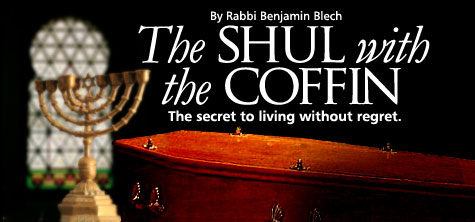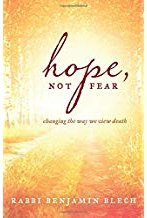 Vampire Weekend's Surprising Jewish Stories
Vampire Weekend's Surprising Jewish Stories


7 min read
The secret to living without regret.
Every year, as the high holy days approach, I remember the strange synagogue in Jerusalem I visited on my first trip to Israel a long time ago.
It was built by Jews who emigrated from somewhere in deepest Africa. They brought with them a very odd custom that was part of their tradition for almost 2000 years.
Like every congregation, there was an ark behind a beautifully decorated curtain, with a number of Torahs inside it. But on the adjacent wall, highlighted by special lighting and built into its surface, was a coffin.
I knew there couldn’t be a body inside. Jewish law forbids Kohanim, the priestly tribe whose descendents still make up a significant number of present-day Jewry, from coming in contact with the dead or even being in the same room with them. It was inconceivable that this was a Jewish version of Westminster Abby, serving as final resting place for some prominent ancestor. That would preclude some Jews from entering.
So I asked, what in the world was a coffin doing so prominently displayed in a synagogue?
The elder of the congregation explained it to me.
Knowing that death awaits helps us evaluate differently everything we do.
“You surely know the mishna in Ethics of the Fathers that says we are to constantly consider three things in order to avoid falling into sin. ‘Know from where you come, to where you are finally going, and before whom you are destined to give a final accounting. You come from a drop of semen; you are going to the grave; and you will have to justify all the deeds of your life before the Creator.’ Awareness of our mortality is the most important truth we must impress upon ourselves every moment in order to live our lives to the fullest."
Gazing at the coffin every day as they occupied themselves with their prayers to God, they had created a visual symbol – not of the affirmation of death – but of the way in which its recognition could transform life.
To the outsider it might appear morbid. To those who understand its message, it is a profound statement with a demand for introspection by its viewers.
Knowing that death awaits us helps us to evaluate everything we do in a different way.
Related Video: Yom Kippur: Partner Track
Rising above Pettiness
A colleague of mine shared with me an incident that took place at a funeral he performed. Immediately after the burial, the husband stood at the grave of his wife and refused to leave. The rabbi said to him: “The service is over. We have to leave.” But the man shook him off and said, “You don’t understand, rabbi. I loved my wife!”
“I am sure you did,” the rabbi said, “but the service is now over. You have to leave.”
Again the man shook the rabbi off and said, “You don’t understand, rabbi. I loved my wife.”
The rabbi tried to get the man to leave a third time. This time the man said, “You don’t understand, rabbi. I loved my wife – and once I almost told her!”
If only the husband had lived his life with an awareness of mortality. If only he had taken to heart the message of the final coffin while it would still have made a difference.
What is it that people do when they know their days are numbered?
They look back with regret at time foolishly wasted.
They wonder why they didn't spend more time with family and friends.
They are filled with remorse at not having sufficiently expressed love, gratitude and kindness to those most precious to them.
They question why they expended so much of their efforts acquiring things they now realize have no long-lasting value.
They can't understand why they allowed pettiness to undo friendships and why they permitted minor slights to stand in the way of meaningful relationships.
If only they could've stared at a coffin whenever they became forgetful of their final end. They would have been given a daily reminder of Disraeli’s warning: Life is too short to be little.
We try to deny death as much as possible. We hesitate to even call it by its name. We use euphemisms to suggest that people pass on, pretending they have simply moved away. We say they depart, they leave us, they rest in peace – as if verbal camouflage could undo reality.
If we only had the courage to face up to what ultimately awaits us we might find the same wisdom with which those who are critically ill are very often gifted.
It is not morbid to tell yourself “I am going to die.” It is liberating. It frees you from being enslaved to what in your heart you know doesn't really matter. It permits you to tell yourself that this is not what you would do or how you would act if you had but one day to live. It allows you to break the chains of habit that shackle you merely because you rationalize they are only temporary. It prevents you from wasting your life while you spend your days preparing to live.
Not such a bad idea, after all, to be forced to face a coffin. And if we have not adopted that custom in our own synagogues, we do have a moment when Jewish tradition commands a comparable ritual.
A kittel is the name of the white linen shroud in which, according to Jewish law, we bury the dead. And there are times when a kittel is also used by the living.
On Yom Kippur the kittel is worn in shul as we offer prayers for forgiveness. During this period the heavenly court reviews our deeds and decides our fate for the year to come. We stand before God as the Books of Life and Death lay open, and we prepare to accept the divine verdict. The kittel is a powerful reminder to appreciate the seriousness of the moment.
The coffin and the kittel, the reminders of our mortality, could help us change the way we live our lives if only we took their message more seriously. On Rosh Hashanah and Yom Kippur our prayers concentrate on life. But they are offered in the context of our awareness of death. And with that knowledge we have the opportunity to turn every additional day we are granted on earth into a time of great blessing and fulfillment.
 An excerpt from Rabbi Blech’s new book Hope, Not Fear: Changing the Way We View Death. Benjamin Blech helps readers approach the end of life with calm. More than six years ago Blech was diagnosed with a fatal illness and given six months to live. Over the course of his career Rabbi Blech had counseled hundreds of people through the losses of loved ones and their own end of life, but when confronted with his own unexpected diagnosis he struggled with mortality in a new way. This personal and heartfelt book shares the answers people grappling with the end of life want to know—from what happens when we die to how we can live fully in the meantime. Drawing insights from many religious traditions as well as near death experiences, Hope, Not Fear shares the wisdom and comfort we all need to view death in an entirely new light. Click here to pre-order.
An excerpt from Rabbi Blech’s new book Hope, Not Fear: Changing the Way We View Death. Benjamin Blech helps readers approach the end of life with calm. More than six years ago Blech was diagnosed with a fatal illness and given six months to live. Over the course of his career Rabbi Blech had counseled hundreds of people through the losses of loved ones and their own end of life, but when confronted with his own unexpected diagnosis he struggled with mortality in a new way. This personal and heartfelt book shares the answers people grappling with the end of life want to know—from what happens when we die to how we can live fully in the meantime. Drawing insights from many religious traditions as well as near death experiences, Hope, Not Fear shares the wisdom and comfort we all need to view death in an entirely new light. Click here to pre-order.
